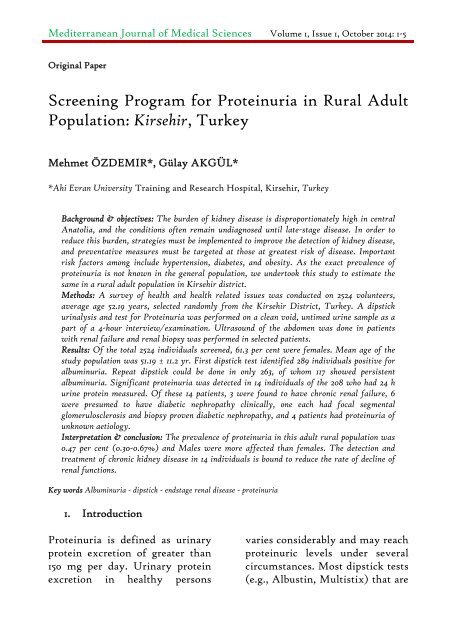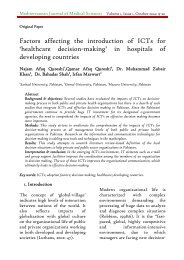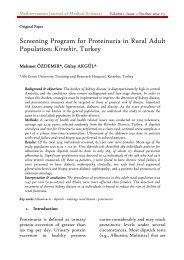Screening Program for Proteinuria in Rural Adult Population: Kirsehir, Turkey
Background & objectives: The burden of kidney disease is disproportionately high in central Anatolia, and the conditions often remain undiagnosed until late-stage disease. In order to reduce this burden, strategies must be implemented to improve the detection of kidney disease, and preventative measures must be targeted at those at greatest risk of disease. Important risk factors among include hypertension, diabetes, and obesity. As the exact prevalence of proteinuria is not known in the general population, we undertook this study to estimate the same in a rural adult population in Kirsehir district. Methods: A survey of health and health related issues was conducted on 2524 volunteers, average age 52.19 years, selected randomly from the Kirsehir District, Turkey. A dipstick urinalysis and test for Proteinuria was performed on a clean void, untimed urine sample as a part of a 4-hour interview/examination. Ultrasound of the abdomen was done in patients with renal failure and renal biopsy was performed in selected patients. Results: Of the total 2524 individuals screened, 61.3 per cent were females. Mean age of the study population was 51.19 ± 11.2 yr. First dipstick test identified 289 individuals positive for albuminuria. Repeat dipstick could be done in only 263, of whom 117 showed persistent albuminuria. Significant proteinuria was detected in 14 individuals of the 208 who had 24 h urine protein measured. Of these 14 patients, 3 were found to have chronic renal failure, 6 were presumed to have diabetic nephropathy clinically, one each had focal segmental glomerulosclerosis and biopsy proven diabetic nephropathy, and 4 patients had proteinuria of unknown aetiology. Interpretation & conclusion: The prevalence of proteinuria in this adult rural population was 0.47 per cent (0.30-0.67%) and Males were more affected than females. The detection and treatment of chronic kidney disease in 14 individuals is bound to reduce the rate of decline of renal functions. Key words: Albuminuria - dipstick - endstage renal disease - proteinuria
Background & objectives: The burden of kidney disease is disproportionately high in central
Anatolia, and the conditions often remain undiagnosed until late-stage disease. In order to
reduce this burden, strategies must be implemented to improve the detection of kidney disease,
and preventative measures must be targeted at those at greatest risk of disease. Important
risk factors among include hypertension, diabetes, and obesity. As the exact prevalence of
proteinuria is not known in the general population, we undertook this study to estimate the
same in a rural adult population in Kirsehir district.
Methods: A survey of health and health related issues was conducted on 2524 volunteers,
average age 52.19 years, selected randomly from the Kirsehir District, Turkey. A dipstick
urinalysis and test for Proteinuria was performed on a clean void, untimed urine sample as a
part of a 4-hour interview/examination. Ultrasound of the abdomen was done in patients
with renal failure and renal biopsy was performed in selected patients.
Results: Of the total 2524 individuals screened, 61.3 per cent were females. Mean age of the
study population was 51.19 ± 11.2 yr. First dipstick test identified 289 individuals positive for
albuminuria. Repeat dipstick could be done in only 263, of whom 117 showed persistent
albuminuria. Significant proteinuria was detected in 14 individuals of the 208 who had 24 h
urine protein measured. Of these 14 patients, 3 were found to have chronic renal failure, 6
were presumed to have diabetic nephropathy clinically, one each had focal segmental
glomerulosclerosis and biopsy proven diabetic nephropathy, and 4 patients had proteinuria of
unknown aetiology.
Interpretation & conclusion: The prevalence of proteinuria in this adult rural population was
0.47 per cent (0.30-0.67%) and Males were more affected than females. The detection and
treatment of chronic kidney disease in 14 individuals is bound to reduce the rate of decline of
renal functions.
Key words: Albuminuria - dipstick - endstage renal disease - proteinuria
You also want an ePaper? Increase the reach of your titles
YUMPU automatically turns print PDFs into web optimized ePapers that Google loves.
Mediterranean Journal of Medical Sciences Volume 1, Issue 1, October 2014: 1-5<br />
Orig<strong>in</strong>al Paper<br />
<strong>Screen<strong>in</strong>g</strong> <strong>Program</strong> <strong>for</strong> <strong>Prote<strong>in</strong>uria</strong> <strong>in</strong> <strong>Rural</strong> <strong>Adult</strong><br />
<strong>Population</strong>: <strong>Kirsehir</strong>, <strong>Turkey</strong><br />
Mehmet ÖZDEMIR*, Gülay AKGÜL*<br />
*Ahi Evran University Tra<strong>in</strong><strong>in</strong>g and Research Hospital, <strong>Kirsehir</strong>, <strong>Turkey</strong><br />
Background & objectives: The burden of kidney disease is disproportionately high <strong>in</strong> central<br />
Anatolia, and the conditions often rema<strong>in</strong> undiagnosed until late-stage disease. In order to<br />
reduce this burden, strategies must be implemented to improve the detection of kidney disease,<br />
and preventative measures must be targeted at those at greatest risk of disease. Important<br />
risk factors among <strong>in</strong>clude hypertension, diabetes, and obesity. As the exact prevalence of<br />
prote<strong>in</strong>uria is not known <strong>in</strong> the general population, we undertook this study to estimate the<br />
same <strong>in</strong> a rural adult population <strong>in</strong> <strong>Kirsehir</strong> district.<br />
Methods: A survey of health and health related issues was conducted on 2524 volunteers,<br />
average age 52.19 years, selected randomly from the <strong>Kirsehir</strong> District, <strong>Turkey</strong>. A dipstick<br />
ur<strong>in</strong>alysis and test <strong>for</strong> <strong>Prote<strong>in</strong>uria</strong> was per<strong>for</strong>med on a clean void, untimed ur<strong>in</strong>e sample as a<br />
part of a 4-hour <strong>in</strong>terview/exam<strong>in</strong>ation. Ultrasound of the abdomen was done <strong>in</strong> patients<br />
with renal failure and renal biopsy was per<strong>for</strong>med <strong>in</strong> selected patients.<br />
Results: Of the total 2524 <strong>in</strong>dividuals screened, 61.3 per cent were females. Mean age of the<br />
study population was 51.19 ± 11.2 yr. First dipstick test identified 289 <strong>in</strong>dividuals positive <strong>for</strong><br />
album<strong>in</strong>uria. Repeat dipstick could be done <strong>in</strong> only 263, of whom 117 showed persistent<br />
album<strong>in</strong>uria. Significant prote<strong>in</strong>uria was detected <strong>in</strong> 14 <strong>in</strong>dividuals of the 208 who had 24 h<br />
ur<strong>in</strong>e prote<strong>in</strong> measured. Of these 14 patients, 3 were found to have chronic renal failure, 6<br />
were presumed to have diabetic nephropathy cl<strong>in</strong>ically, one each had focal segmental<br />
glomerulosclerosis and biopsy proven diabetic nephropathy, and 4 patients had prote<strong>in</strong>uria of<br />
unknown aetiology.<br />
Interpretation & conclusion: The prevalence of prote<strong>in</strong>uria <strong>in</strong> this adult rural population was<br />
0.47 per cent (0.30-0.67%) and Males were more affected than females. The detection and<br />
treatment of chronic kidney disease <strong>in</strong> 14 <strong>in</strong>dividuals is bound to reduce the rate of decl<strong>in</strong>e of<br />
renal functions.<br />
Key words Album<strong>in</strong>uria - dipstick - endstage renal disease - prote<strong>in</strong>uria<br />
1. Introduction<br />
<strong>Prote<strong>in</strong>uria</strong> is def<strong>in</strong>ed as ur<strong>in</strong>ary<br />
prote<strong>in</strong> excretion of greater than<br />
150 mg per day. Ur<strong>in</strong>ary prote<strong>in</strong><br />
excretion <strong>in</strong> healthy persons<br />
varies considerably and may reach<br />
prote<strong>in</strong>uric levels under several<br />
circumstances. Most dipstick tests<br />
(e.g., Albust<strong>in</strong>, Multistix) that are
Mediterranean Journal of Medical Sciences V1, I1 October 2014: 1-5 2<br />
positive <strong>for</strong> prote<strong>in</strong> are a result of<br />
benign prote<strong>in</strong>uria, which has no<br />
associated morbidity or<br />
mortality[5] . Among the various<br />
predictors of progression of<br />
chronic kidney disease to end<br />
stage renal disease (ESRD),<br />
prote<strong>in</strong>uria is the most potent<br />
predictor[6]. Angiotens<strong>in</strong><br />
convert<strong>in</strong>g enzyme (ACE)<br />
<strong>in</strong>hibitors (ACEi) and angiotens<strong>in</strong><br />
II receptor blockers (ARB) have<br />
been given to persons with<br />
prote<strong>in</strong>uria and chronic kidney<br />
disease to decrease the progression<br />
to end stage renal disease[4,7-11],<br />
treatment of prote<strong>in</strong>uric patients<br />
with ACEi and ARB has been<br />
shown to decrease the rate of<br />
progression of chronic kidney<br />
disease.<br />
S<strong>in</strong>ce the exact prevalence and<br />
cause of prote<strong>in</strong>uria as a marker of<br />
kidney disease is not known <strong>in</strong><br />
our population, we undertook this<br />
study to estimate the same <strong>in</strong> a<br />
rural population <strong>in</strong> <strong>Kirsehir</strong>.<br />
2. Material & Methods<br />
A convenient sample of 2524<br />
adults (aged 40 yr and above)<br />
from rural area of <strong>Kirsehir</strong>, <strong>Turkey</strong><br />
was <strong>in</strong>cluded <strong>in</strong> the study. The<br />
study was carried out <strong>for</strong> a period<br />
of 24 months between April 2011<br />
and April 2013. Individuals were<br />
selected under an ongo<strong>in</strong>g<br />
community health programme by<br />
the Department of Urology, Ahi<br />
Evran University Tra<strong>in</strong><strong>in</strong>g and<br />
Research Hospital, <strong>Kirsehir</strong>,<br />
<strong>Turkey</strong>.<br />
After expla<strong>in</strong><strong>in</strong>g about the<br />
objective of the study, <strong>in</strong>dividuals<br />
were tested <strong>for</strong> album<strong>in</strong>uria by<br />
dipstick exam<strong>in</strong>ation (Multistix<br />
SG, Bayer Diagnostics) <strong>in</strong> an<br />
untimed ur<strong>in</strong>e sample. Individuals<br />
who had acute illness, non<br />
ambulatory persons and<br />
menstruat<strong>in</strong>g women were<br />
excluded. Individuals tested<br />
positive <strong>for</strong> album<strong>in</strong>uria<br />
underwent a second dipstick<br />
exam<strong>in</strong>ation after a gap of one<br />
week. Repeat dipstick was<br />
per<strong>for</strong>med to rule out transient<br />
prote<strong>in</strong>uria.<br />
Individuals with persistent<br />
album<strong>in</strong>uria on the second<br />
dipstick exam<strong>in</strong>ation underwent<br />
further evaluation at the which<br />
<strong>in</strong>cluded medical history, physical<br />
exam<strong>in</strong>ation, 24 h ur<strong>in</strong>e prote<strong>in</strong><br />
estimation, total serum prote<strong>in</strong><br />
and album<strong>in</strong> estimation. Those<br />
who had prote<strong>in</strong>uria (prote<strong>in</strong><br />
excretion >150 mg/day on 24 h<br />
ur<strong>in</strong>e prote<strong>in</strong> estimation)<br />
underwent ur<strong>in</strong>e microscopic<br />
exam<strong>in</strong>ation, blood urea and<br />
serum creat<strong>in</strong><strong>in</strong>e, fast<strong>in</strong>g and<br />
postprandial blood sugar level<br />
estimations. Ultrasound of the<br />
abdomen was done <strong>in</strong> patients<br />
with renal failure (serum<br />
creat<strong>in</strong><strong>in</strong>e >1.4 mg/dl). Renal<br />
biopsy was per<strong>for</strong>med <strong>in</strong> patients<br />
with prote<strong>in</strong>uria >1 g/day or<br />
©2014 Mediterranean Center of Medical Sciences
M. ÖZDEMIR, G. AKGÜL 3<br />
prote<strong>in</strong>uria with an active ur<strong>in</strong>ary<br />
sediment or with renal failure. To<br />
facilitate the participation,<br />
dipstick exam<strong>in</strong>ation <strong>for</strong><br />
album<strong>in</strong>uria was per<strong>for</strong>med at the<br />
<strong>in</strong>dividual’s residence.<br />
3. Results & Discussion<br />
Of a total of 2524 <strong>in</strong>dividuals<br />
screened, 1548 (61.3%) were<br />
women. The age ranged from 40<br />
to 90 yr with a mean age of 51.19 ±<br />
11.2 yr. First dipstick test<br />
identified 59 <strong>in</strong>dividuals with<br />
positive <strong>for</strong> album<strong>in</strong>uria. Of these,<br />
repeat dipstick could be done <strong>in</strong> 57<br />
diabetic nephropathy cl<strong>in</strong>ically<br />
(diabetics with prote<strong>in</strong>uria,<br />
diabetic ret<strong>in</strong>opathy and <strong>in</strong>active<br />
ur<strong>in</strong>ary sediment). Seven patients<br />
who had prote<strong>in</strong>uria of unknown<br />
aetiology, were not subjected to<br />
renal biopsy as criteria <strong>for</strong> biopsy<br />
were not met (prote<strong>in</strong>uria of less<br />
than 1 g/day, normal renal<br />
function and bland ur<strong>in</strong>ary<br />
sediment). Two patients<br />
underwent renal biopsy and it<br />
showed focal segmental<br />
glomerulosclerosis <strong>in</strong> one and<br />
diabetic nephropathy <strong>in</strong> the other<br />
The follow<strong>in</strong>g thresholds have<br />
been considered, as summarised<br />
here:<br />
Table 1<br />
ACR<br />
PCR Implication<br />
(mg/mmol) (mg/mmol)<br />
>2.5/3.5 >15 Abnormal (ACR values are <strong>for</strong> male, female):<br />
adequate to def<strong>in</strong>e CKD 1 or 2.<br />
Commence ACEI/ARB if diabetic(**).<br />
30 50 Favour ACE <strong>in</strong>hibitor/ ARB if hypertensive<br />
Suffix 'p' on CKD stage<br />
70 100<br />
Referral threshold <strong>in</strong> non-diabetics<br />
>250 >300 Approximately 'nephrotic range' prote<strong>in</strong>uria<br />
<strong>in</strong>dividuals of whom 21 showed<br />
persistent<br />
album<strong>in</strong>uria.<br />
Significant prote<strong>in</strong>uria was<br />
detected <strong>in</strong> 14 (8 males, 6 females)<br />
of the 20 <strong>in</strong>dividuals with<br />
persistent album<strong>in</strong>uria who had 24<br />
h ur<strong>in</strong>e prote<strong>in</strong> measured. Further<br />
evaluation of these 20 subjects<br />
revealed chronic renal failure <strong>in</strong><br />
three by biochemical and<br />
ultrasound exam<strong>in</strong>ations. Twelve<br />
patients were presumed to have<br />
The prevalence of prote<strong>in</strong>uria <strong>in</strong><br />
the study population was 0.47 per<br />
cent (0.30-0.67%) us<strong>in</strong>g album<strong>in</strong><br />
dipstick as a screen<strong>in</strong>g test.<br />
Prevalence <strong>in</strong> males and females<br />
was 0.75 per cent (0.35-1.14%) and<br />
0.31 per cent (0.11-0.50%)<br />
respectively (Table 2).<br />
The female preponderance <strong>in</strong> the<br />
study sample was probably a<br />
reflection of the fact that the men<br />
http://www.mcmscience.org
Mediterranean Journal of Medical Sciences V1, I1 October 2014: 1-5 4<br />
were away from home at work<br />
dur<strong>in</strong>g the time of sample<br />
collection. Among the various<br />
aetiological factors, diabetic<br />
nephropathy was found <strong>in</strong> 7 of 14<br />
patients (50%) with prote<strong>in</strong>uria.<br />
Seven patients with significant<br />
prote<strong>in</strong>uria not meet<strong>in</strong>g the<br />
criteria <strong>for</strong> a renal biopsy are<br />
be<strong>in</strong>g followed up. Patients with<br />
diabetic nephropathy were<br />
advised euglycaemic measures and<br />
are on follow up with the health<br />
department. One <strong>in</strong>dividual with<br />
focal<br />
segmental<br />
glomerulosclerosis was treated<br />
parts of the country may prove to<br />
be an effective measure <strong>in</strong><br />
reduc<strong>in</strong>g the burden of chronic<br />
kidney disease.<br />
Acknowledgment<br />
The authors thank tra<strong>in</strong>ed health<br />
care workers at Ahi Evran<br />
University Tra<strong>in</strong><strong>in</strong>g and Research<br />
Hospital, <strong>Kirsehir</strong>, <strong>Turkey</strong> <strong>for</strong><br />
their assistance <strong>in</strong> per<strong>for</strong>m<strong>in</strong>g<br />
ur<strong>in</strong>e dipstick exam<strong>in</strong>ation.<br />
Table 2. Prevalence rate of prote<strong>in</strong>uria (%) accord<strong>in</strong>g to age and gender<br />
Age Males Females<br />
(yr) (N) Prevalence (N) Prevalence<br />
40-59 621 0.60 (0.58 - 0.62) 1050 0.62 (0.61 - 0.64)<br />
60-79 319 0.32 (0.30 - 0.34) 441 0.35 (0.347 -0.349)<br />
>80 36 0.07 (0.06 - 0.09) 57 0.03 (0.027 -0.029)<br />
Total 976 1548<br />
Values <strong>in</strong> parentheses <strong>in</strong>dicate range<br />
with ACEi and has stable renal<br />
function. The risk of renal failure<br />
is greater <strong>in</strong> younger patients.<br />
In conclusion, although the<br />
prevalence of prote<strong>in</strong>uria <strong>in</strong> this<br />
rural population was low,<br />
detection and treatment of chronic<br />
kidney disease <strong>in</strong> 14 <strong>in</strong>dividuals<br />
with prote<strong>in</strong>uria is likely to reduce<br />
the rate of decl<strong>in</strong>e of renal<br />
function. Similar screen<strong>in</strong>g<br />
programmes <strong>for</strong> prote<strong>in</strong>uria with<br />
proper study design <strong>in</strong> different<br />
References<br />
1. Nakopoulou L, Stefananki K, Papadakis<br />
J,Boletis J, Zeis PM, Kostakis A et<br />
al. Expression of bcl-2 oncoprote<strong>in</strong><br />
<strong>in</strong> various types of<br />
glomerulonephritis and renal<br />
allografts. Nephrol Dial Transplant<br />
1996; 11: 997–1002<br />
2. Gerste<strong>in</strong> HC, Mann JF, Yi Q, et al.<br />
Album<strong>in</strong>uria and risk of<br />
cardiovascular events, death, and<br />
heart failure <strong>in</strong> diabetic and<br />
nondiabetic <strong>in</strong>dividuals. JAMA 2001;<br />
286 : 421-6.<br />
©2014 Mediterranean Center of Medical Sciences
M. ÖZDEMIR, G. AKGÜL 5<br />
3. James PA, Oparil S, Carter BL, et al. 2014<br />
evidence-based guidel<strong>in</strong>e <strong>for</strong> the<br />
management of high blood pressure<br />
<strong>in</strong> adults—report from the panel<br />
members appo<strong>in</strong>ted to the Eighth<br />
Jo<strong>in</strong>t National Committee (JNC 8).<br />
The Journal of the American Medical<br />
Association. Published onl<strong>in</strong>e<br />
December 18, 2013.<br />
4. Anastasio, P, Spitali, L, Frangiosa, A,<br />
Mol<strong>in</strong>o, D, Stellato, D, Cirillo, E,<br />
Pollastro, RM, Capodicasa, L, Sepe,<br />
J, Federico, P, Gaspare De Santo, N<br />
(2000) Glomerular filtration rate <strong>in</strong><br />
severely overweight normotensive<br />
humans. Am J Kidney Dis 35 (6)<br />
1144-1148.<br />
5. L<strong>in</strong>dholm LH, Ibsen H, Dahlof B, et al.<br />
Cardiovascular morbidity and<br />
mortality <strong>in</strong> patients with diabetes<br />
<strong>in</strong> the Losartan Intervention For<br />
Endpo<strong>in</strong>t Reduction <strong>in</strong><br />
Hypertension Study (LIFE): a<br />
randomised trial aga<strong>in</strong>st atenolol.<br />
Lancet 2002; 359 : 1004-10.<br />
6. Jafar TH, Schmid CH, Landa M, et al.<br />
Angiotens<strong>in</strong>-convert<strong>in</strong>g enzyme<br />
<strong>in</strong>hibitors and progression of<br />
nondiabetic renal disease: a metaanalysis<br />
of patient-level data. Ann<br />
Intern Med 2001; 135 : 73-87.<br />
7. Uluhan A, Paydaş S, Sağlıker Y, Demirtaş<br />
M, Bozdemir H, Sarıca Y: Low<br />
blood pressure and amyloidosis.<br />
Nephron 1995; 69: 118-119<br />
8. Agodoa LY, Appel L, Bakris GL, et al.<br />
Effect of ramipril vs amlodip<strong>in</strong>e on<br />
renal outcomes <strong>in</strong> hypertensive<br />
nephrosclerosis: a randomized<br />
controlled trial. JAMA 2001; 285 :<br />
2719-28.<br />
9. Lewis EJ, Hunsicker LG, Clarke WR, et al.<br />
Renoprotective effect of the<br />
angiotens<strong>in</strong>-receptor antagonist<br />
irbesartan <strong>in</strong> patients with<br />
nephropathy due to type 2 diabetes.<br />
N Engl J Med 2001; 345 : 851-60.<br />
10. Brenner BM, Cooper ME, de Zeeuw D, et<br />
al. Effects of losartan on renal and<br />
cardiovascular outcomes <strong>in</strong> patients<br />
with type 2 diabetes and<br />
nephropathy. N Engl J Med 2001; 345<br />
: 861-9.<br />
11. Saatçi Ü, Özdemir S, Özen S, Bakkaloğlu<br />
A: Serum concentration and ur<strong>in</strong>ary<br />
excretion of beta 2 microglobul<strong>in</strong><br />
and microalbum<strong>in</strong>uria <strong>in</strong>familial<br />
Mediterranean fever. Arch Dis<br />
Child 1994; 70: 27-29<br />
12. Aktuğ H, Çet<strong>in</strong>taş VB, Kosova B, Oltulu<br />
F, Demiray ŞB, Çavuşoğlu T et al.<br />
Dysregulation of nitric oxide<br />
synthase activity and Bcl-2 and<br />
caspase-3 gene expressions <strong>in</strong> renal<br />
tissue of streptozotoc<strong>in</strong>-<strong>in</strong>duced<br />
diabetic rats. Turk J Med Sci 2012;<br />
42: 830–8<br />
http://www.mcmscience.org








